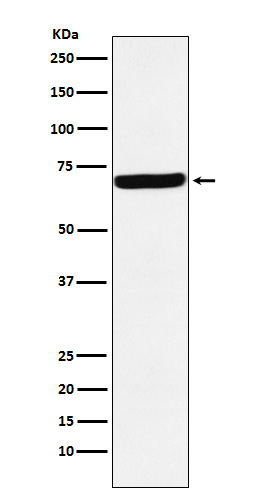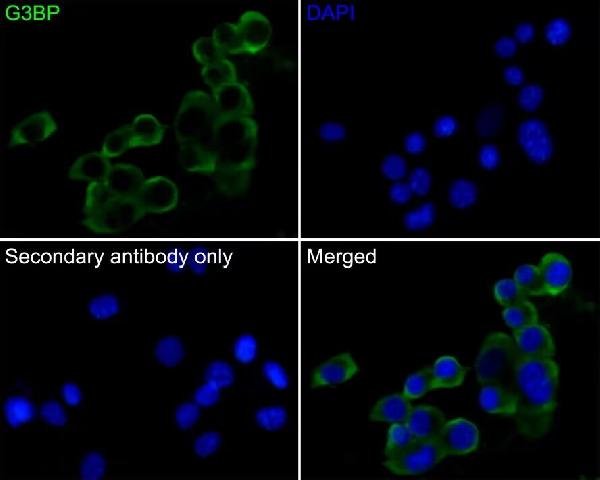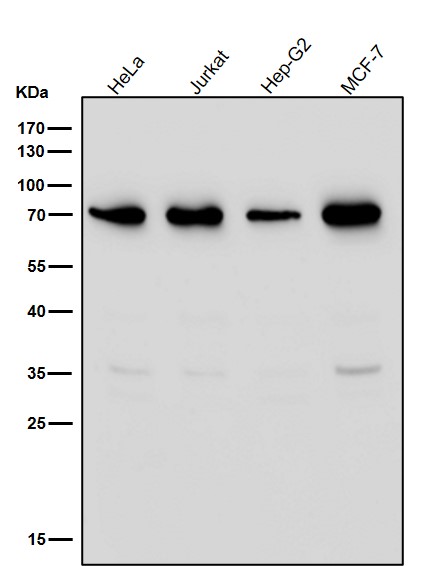Anti-G3BP Rabbit Monoclonal Antibody
- SPECIFICATION
- CITATIONS
- PROTOCOLS
- BACKGROUND

Application
| WB, IHC, IF, ICC, IP, FC |
|---|---|
| Primary Accession | Q13283 |
| Host | Rabbit |
| Isotype | IgG |
| Reactivity | Rat, Human, Mouse |
| Clonality | Monoclonal |
| Format | Liquid |
| Description | Anti-G3BP Rabbit Monoclonal Antibody . Tested in WB, IHC, ICC/IF, IP, Flow Cytometry applications. This antibody reacts with Human, Mouse, Rat. |
| Gene ID | 10146 |
|---|---|
| Other Names | Ras GTPase-activating protein-binding protein 1, G3BP-1, 3.6.4.12, 3.6.4.13, ATP-dependent DNA helicase VIII, hDH VIII, GAP SH3 domain-binding protein 1, G3BP1 {ECO:0000303|PubMed:23279204, ECO:0000312|HGNC:HGNC:30292} |
| Calculated MW | 68 kDa |
| Application Details | WB 1:500-1:2000 IHC 1:50-1:200 ICC/IF 1:50-1:200 IP 1:20 FC 1:50 |
| Contents | Rabbit IgG in phosphate buffered saline, pH 7.4, 150mM NaCl, 0.02% sodium azide and 50% glycerol, 0.4-0.5mg/ml BSA. |
| Clone Names | Clone: 22G81 |
| Immunogen | A synthesized peptide derived from human G3BP |
| Purification | Affinity-chromatography |
| Storage | Store at -20°C for one year. For short term storage and frequent use, store at 4°C for up to one month. Avoid repeated freeze-thaw cycles. |
| Name | G3BP1 {ECO:0000303|PubMed:23279204, ECO:0000312|HGNC:HGNC:30292} |
|---|---|
| Function | Protein involved in various processes, such as stress granule formation and innate immunity (PubMed:12642610, PubMed:20180778, PubMed:23279204, PubMed:30510222, PubMed:30804210). Plays an essential role in stress granule formation (PubMed:12642610, PubMed:20180778, PubMed:23279204, PubMed:32302570, PubMed:32302571, PubMed:32302572, PubMed:34739333, PubMed:35977029, PubMed:36183834, PubMed:36279435, PubMed:36692217, PubMed:37379838). Stress granules are membraneless compartments that store mRNAs and proteins, such as stalled translation pre-initiation complexes, in response to stress (PubMed:12642610, PubMed:20180778, PubMed:23279204, PubMed:27022092, PubMed:32302570, PubMed:32302571, PubMed:32302572, PubMed:36279435, PubMed:37379838). Promotes formation of stress granules phase-separated membraneless compartment by undergoing liquid-liquid phase separation (LLPS) upon unfolded RNA-binding: functions as a molecular switch that triggers RNA-dependent LLPS in response to a rise in intracellular free RNA concentrations (PubMed:32302570, PubMed:32302571, PubMed:32302572, PubMed:34739333, PubMed:36279435, PubMed:36692217). Also acts as an ATP- and magnesium-dependent helicase: unwinds DNA/DNA, RNA/DNA, and RNA/RNA substrates with comparable efficiency (PubMed:9889278). Acts unidirectionally by moving in the 5' to 3' direction along the bound single-stranded DNA (PubMed:9889278). Unwinds preferentially partial DNA and RNA duplexes having a 17 bp annealed portion and either a hanging 3' tail or hanging tails at both 5'- and 3'-ends (PubMed:9889278). Plays an essential role in innate immunity by promoting CGAS and RIGI activity (PubMed:30510222, PubMed:30804210). Participates in the DNA-triggered cGAS/STING pathway by promoting the DNA binding and activation of CGAS (PubMed:30510222). Triggers the condensation of cGAS, a process probably linked to the formation of membrane-less organelles (PubMed:34779554). Enhances also RIGI-induced type I interferon production probably by helping RIGI at sensing pathogenic RNA (PubMed:30804210). May also act as a phosphorylation- dependent sequence-specific endoribonuclease in vitro: Cleaves exclusively between cytosine and adenine and cleaves MYC mRNA preferentially at the 3'-UTR (PubMed:11604510). |
| Cellular Location | Cytoplasm, cytosol. Perikaryon {ECO:0000250|UniProtKB:P97855}. Cytoplasm, Stress granule. Nucleus Note=Cytoplasmic in proliferating cells (PubMed:11604510). Cytosolic and partially nuclear in resting cells (PubMed:11604510). Recruited to stress granules in response to arsenite treatment (PubMed:12642610, PubMed:20180778). The unphosphorylated form is recruited to stress granules (PubMed:12642610). HRAS signaling contributes to this process by regulating G3BP dephosphorylation (PubMed:12642610) |
| Tissue Location | Ubiquitous.. |

Thousands of laboratories across the world have published research that depended on the performance of antibodies from Abcepta to advance their research. Check out links to articles that cite our products in major peer-reviewed journals, organized by research category.
info@abcepta.com, and receive a free "I Love Antibodies" mug.
Provided below are standard protocols that you may find useful for product applications.
If you have used an Abcepta product and would like to share how it has performed, please click on the "Submit Review" button and provide the requested information. Our staff will examine and post your review and contact you if needed.
If you have any additional inquiries please email technical services at tech@abcepta.com.













 Foundational characteristics of cancer include proliferation, angiogenesis, migration, evasion of apoptosis, and cellular immortality. Find key markers for these cellular processes and antibodies to detect them.
Foundational characteristics of cancer include proliferation, angiogenesis, migration, evasion of apoptosis, and cellular immortality. Find key markers for these cellular processes and antibodies to detect them. The SUMOplot™ Analysis Program predicts and scores sumoylation sites in your protein. SUMOylation is a post-translational modification involved in various cellular processes, such as nuclear-cytosolic transport, transcriptional regulation, apoptosis, protein stability, response to stress, and progression through the cell cycle.
The SUMOplot™ Analysis Program predicts and scores sumoylation sites in your protein. SUMOylation is a post-translational modification involved in various cellular processes, such as nuclear-cytosolic transport, transcriptional regulation, apoptosis, protein stability, response to stress, and progression through the cell cycle. The Autophagy Receptor Motif Plotter predicts and scores autophagy receptor binding sites in your protein. Identifying proteins connected to this pathway is critical to understanding the role of autophagy in physiological as well as pathological processes such as development, differentiation, neurodegenerative diseases, stress, infection, and cancer.
The Autophagy Receptor Motif Plotter predicts and scores autophagy receptor binding sites in your protein. Identifying proteins connected to this pathway is critical to understanding the role of autophagy in physiological as well as pathological processes such as development, differentiation, neurodegenerative diseases, stress, infection, and cancer.




